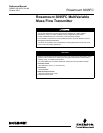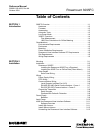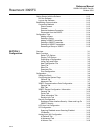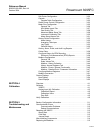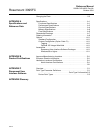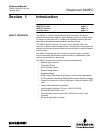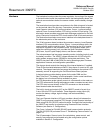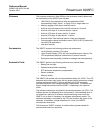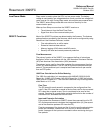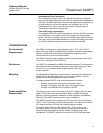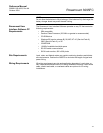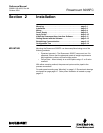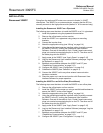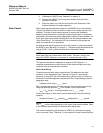
Reference Manual
00809-0100-4832, Rev AA
October 2004
Rosemount 3095FC
1-2
Hardware The backplane board provides the power regulation, the routing of the signals
to the termination board, the processor board, the backup battery board, the
optional communications board, the sensor module, and the battery charger
board.
The termination board provides connections to the field wiring and is located
on the terminal side of the housing. Connections include the power supply,
Local Operator Interface (LOI) communications, Comm 1 communications,
optional Comm 2 communications, RTD wiring, and the I/O field wiring. The
termination board provides surge and static discharge protection for the field
wiring. Electronics include the RTD circuits and the final I/O drivers/receivers.
The termination board also serves as an interface to the backplane board in
the electronics portion of the enclosure.
The 32-bit processor board contains the processor, memory, Local Operator
Interface (LOI) communications driver, Comm 1 communications driver, the
reset controller, and the real-time clock. The functions for the I/O of analog
conversion originate on the processor board. The processor board, also
called the central processor unit, provides the Serial Peripheral Interface
(SPI) buss, Liquid Crystal Display drivers, and Sensor module.
The microprocessor has low-power operating modes, including inactivity and
low battery condition. The 3095FC comes standard with 512 KB of built-in,
static random access memory (SRAM) for storing data and history. The
3095FC also has 2 MB of flash ROM for storing operating system firmware,
applications firmware, and configuration parameters.
The charger board controls the charging of the internal batteries, if installed.
Three D-size lead-acid batteries provide 2.5 Amp-hours of current at 6.2 volts
nominal. The charger board also serves as the interface to the optional LCD
assembly, as well as supporting the On/Off and Norm/Reset jumpers.
A backup battery provides backup power for the static RAM and the
Real-Time Clock. This battery is field replaceable. Under normal conditions,
the battery has a functional life that exceeds five years.
An RTD temperature probe typically mounts in a thermowell on the meter run.
The RTD measures the flowing temperatures under a constant current drive.
The RTD wires connect directly to the RTD connector on the termination
board located inside the enclosure.
The built-in inputs and outputs (I/O) on the 3095FC consist of a port for a
3-wire 100-ohm RTD input interface. Three diagnostic analog inputs (AI)
monitor the battery voltage, logical voltage, and enclosure/battery
temperature.
The Local Operator Interface (LOI) port provides a direct link between the
3095FC and a personal computer (PC) through a Local Operator Interface
Cable using EIA-232 (RS-232) communications. Configure the functionality of
the 3095FC and monitor its operation using Rosemount User Interface
Software (see Section 3: Configuration).
The Comm 1 allows for EIA-485 (RS-485) serial communication protocols.
The EIA-232 (RS-232) activates Comm 2. “Establishing Communication” on
page 2-13
The I/O parameters, Sensor inputs, flow calculations, power control, and
security are configured and accessed using the configuration options
available in Section 3: Configuration.




